Laura talks about her move to Ulsan, South Korea, and gives you her best advice for moving, including the culture shock and missing your home country, the language barrier, food (and what to do as a vegetarian!), public transportation and travel to other asian countries, the weather, and Korean Society and people South Korea.
Everything You Need to Know About Living in South Korea
As promised, this week I will be talking to you about my experience of living in South Korea.
In 2019, I accepted a job as an English teacher in an international school in South Korea. Before taking the job, I hardly knew anything about the country. In fact, admittedly, I was pretty ignorant and had to search online for which part of Korea it was and whether it was safe to travel to.
I was based in a city called Ulsan which is near Busan. For those who don’t know it, Busan is the second largest city in South Korea and is based on the south east coast. Ulsan however, is a much smaller city in a rural area just above Busan. I couldn’t find much online about Ulsan so I really wasn’t sure what to expect when I arrived but luckily, I fell in love with it.
As promised, this week I will be talking to you about my experience of living in South Korea.
If you\’re looking to move to South Korea to become an English teacher, check out my guide to teaching abroad in South Korea!
Culture Shock – South Korean Society
The first thing that everyone asks when you move abroad is ‘Did you get culture shock?’.
Did I get culture shock? Honestly – not really. I had mentally prepared myself to experience culture shock and in fact, South Korean Culture and South Koreans were not as different from the UK (my home country) as I had imagined – at least, the lifestyle wasn’t. The main shock for me was the food and the language barrier.
However, this really depends on where you stay. Seoul, the captial city, is very progressive and you will find that there are many western influences. However, if you are living in a small fishing town or some of the more rural areas in South Korea, for example, you may be surrounded by older traditions.
For example, in the Korean language, there is no word for vegetarian – simply because most people are not vegetarians over there. Most meals contain either meat or fish and they will use fish sauce in their cooking. However, if you visit Seoul or other major cities, you will now find lots of vegetarian, or even vegan restaurants. This would be harder to find in rural areas.
Language Barrier
Being from England, we often get a bad reputation for not learning other languages – almost everywhere we go, people will adjust to speaking English to cater for us. However, in Korea, even though the younger generation learn English at school, many of the older generation do not speak English and unfortunately, South Korean was not an option to learn at GCSE.
This landed me in a tricky spot a few times – especially when it came to getting lost or shopping in the supermarkets.
For the most part, I was able to get by and I quickly learned a few phrases that were helpful, such as asking for the bill or for bin bags in the 24-hour convenience stores. However, I did have one particular scenario where not understanding the language led to me getting very overwhelmed and upset on public transport and vowing that I was definitely going to be leaving the country because I couldn’t cope (after I got over my tantrum, I calmed down and inevitably did not leave). The point is that the language barrier can be a challenge and sometimes it can make you feel a million miles away from home. The good thing is that everyone was so helpful and would try to understand and help, despite the language barrier.
Food in South Korea
If you love spicy food and meat, you will love the food! Of course, this is generalizing. But in general, the food contains meat or fish and is often very spicy.
For me, before moving to Korea, I had never tried Korean food. Since this time, it has become much more popular in other countries and if you have visited a Korean BBQ restaurant, you will know that the food is delicious! In fact, the food is probably the thing that I miss most about living in Korea.
I think my favourite thing about the food in Korea was the sharing culture. Most dishes are served in a large bowl that you can share with your family or friends. Like Korean BBQ, many of them are also self-cooked which makes it a fun and vibrant atmosphere with amazing smells.
I was lucky that the school that I worked in provided food for lunch so I would fill up every afternoon with a delicious home cooked Korean meal which would save me from having to cook a large meal in the evenings. In fact, I just lived off ramen for dinner.
For the first few weeks, I had the dreaded task of learning to use chopsticks and I would end up in floods of tears during every meal because of the level of spice but I quickly became more tolerant to the spice and was soon praised for my chopstick use. In fact, I actually love to eat with chopsticks at home now when I can – particularly noodles.
You may hear that eating out is cheaper than buying ingredients in their 24-hour convenience stores. I found it quite difficult to buy ingredients for cooking as the larger supermarkets mostly sold products in very large packs (such as vegetables), and I simply could not get through them on my own.
If you do wish to cook, many Korean apartments do not have ovens so most food is cooked on the hob or the rice cooker. However, it is true that the food in the restaurants is so good and so cheap that you will want to eat out a lot!
As previously mentioned, if you are vegetarian or vegan, you will find it harder to eat out in restaurants but the larger supermarkets do sell some vegetarian alternatives that you can cook yourself.
Public Transportation and Travelling around South Korea
For the first few weeks, I found travelling around Korea difficult. Until you receive your ARC (Alien Registration Card for foreign nationals) you can’t get a phone contract, and without WIFI or data, it is nearly impossible to find your way around, especially on public transportation.
If you plan to visit or move to Korea, you will need to download Kakao maps as they do not use Google maps and you can’t use this for navigation in Korea. Once you have WIFI or data and can access Kakao maps, travelling around Korea, and public transportation, becomes very easy!
One great thing about travelling in Korea is that public transportation is always on time so you don’t have to worry about being late. But just make sure that you get to the train station on time!
Buses are frequent and you can use your phone to pay on entrance and exit. Most of the train stations have a Dunkin Donuts so it became tradition that my friends and I would have a donut for breakfast every time we would go on a trip.
The trains are called KTX and they are high-speed so getting between cities is fast. While I was there, I had weekends off work so I would spend most weekends visiting some of the major cities such as Seoul, Busan and Daegu.
It’s also a great place for visiting other Asian countries.
The cities are bustling and vibrant and there is so much to see and do, such as shopping, sight-seeing or hopping between coffee shops.

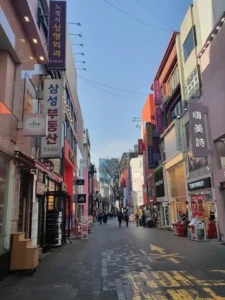
I particularly loved finding the beautiful abundance of instagrammable cafes and coffee shops!


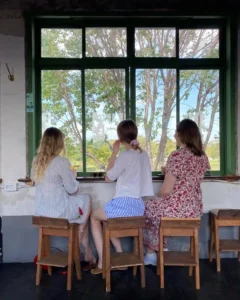
You can also visit some of the more traditional towns and villages such as Gyeongju-si and Gwangju. Here, you will be in awe of the beautiful traditional hanok style buildings, temples, try some traditional Korean tea and see people wearing hanboks (traditional Korean clothing). You can even hire it and wear it for yourself – Koreans love to see you do this.

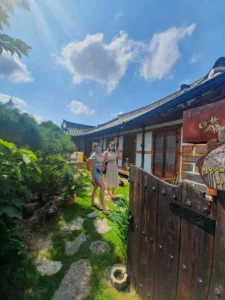
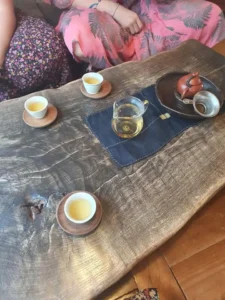
Korea also has some beautiful islands that you can visit. Some, you can get to by car or bus, such as Geoje, whereas others you will need to fly to.
To get to Jeju island (the most popular and well known island), you will need to fly or take a ferry. Flying is very quick and cheap. I visited Jeju island twice while I was living in Korea and I would definitely recommend going in Spring or Summer. The winds can be strong on the island but if you go in spring or summer, you will catch the beautiful colours and glorious weather. It really does feel like a tropical paradise.


The Weather
I remember the first day that I arrived in Korea. It was August and I arrived in sweatpants and a fleece that I had been travelling in. Between that and the large amount of luggage that I was carrying on and off on public transport, I quickly began to melt. In Korea, the summers are very hot and the winters are very cold and dry – the seasons were similar to what I was used to in the UK but much more extreme. In summer, the temperature would sit at around 35 degrees Celsius during the day and it was extremely humid.
On my first evening, I went for a walk around my local area and returned looking like Monica from Friends – my curly hair could not be tamed in that humidity. I remember thinking that I would never be able to work and live in that heat and humidity but I adjusted really quickly and I began to love the warm summers – that feeling of being able to wander around in the evenings with shorts and a T-shirt is a bit of me!
Korea is also prone to typhoons which occur around 6 times a year – most commonly in August and September.
One of the things that I noticed about the weather in Korea is that most of the time it was blue skies – even in the winter. But, when it rains, it POURS! In the UK, people will often not use an umbrella but Koreans would think you were pretty nuts if you were out there without an umbrella – although it really is that kind of wind and rain that is going to flip an umbrella on its head!
Despite the occasional wind and rain, Korea looks beautiful in all weathers.
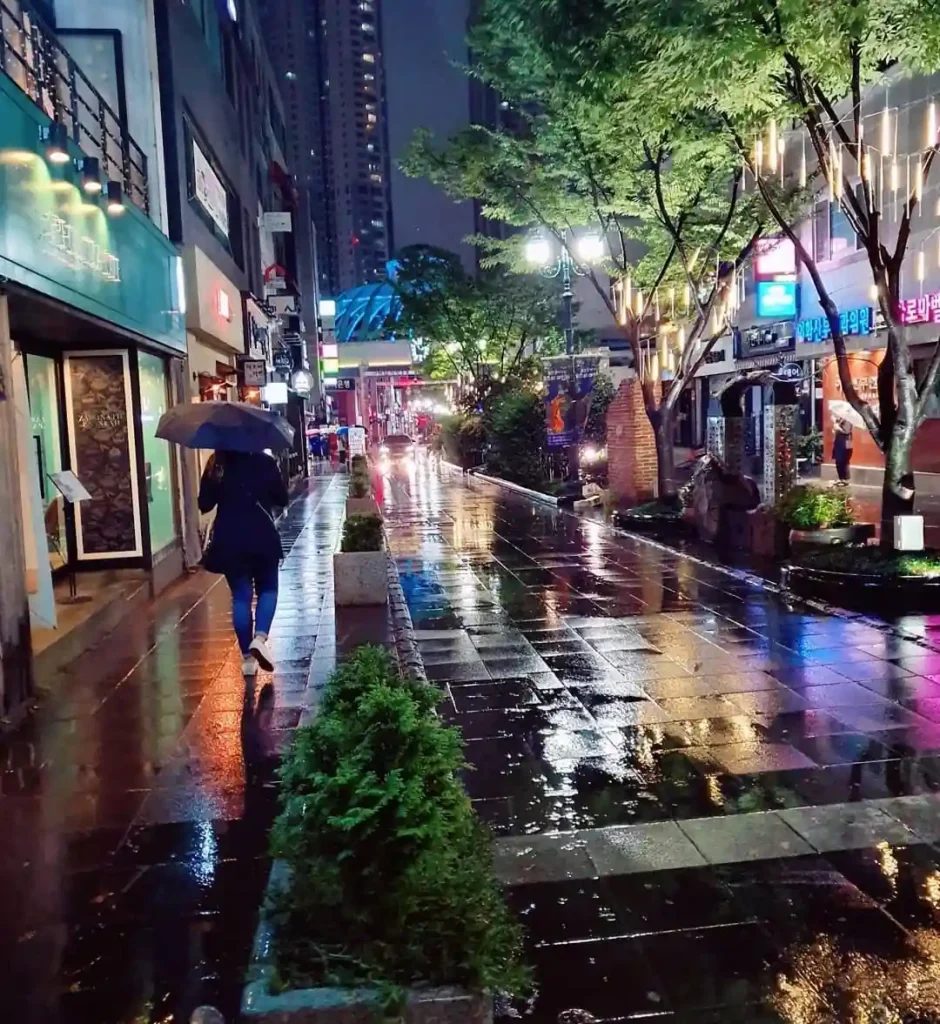
The People in South Korea
Of course, one of the main things that I was worried about when moving to a foreign country was if people would be nice and meeting new people.
Safe to say, South Koreans are very friendly and helpful and it is one of the things that made Korea such a great place to live!
As well as the locals, I was lucky that I lived in an area that had a large immigrant community where I made a large group of friends. There were some bars specifically catered for immigrants and you will find that some bars may specify no foreigners as they may have had trouble in the bars in the past.
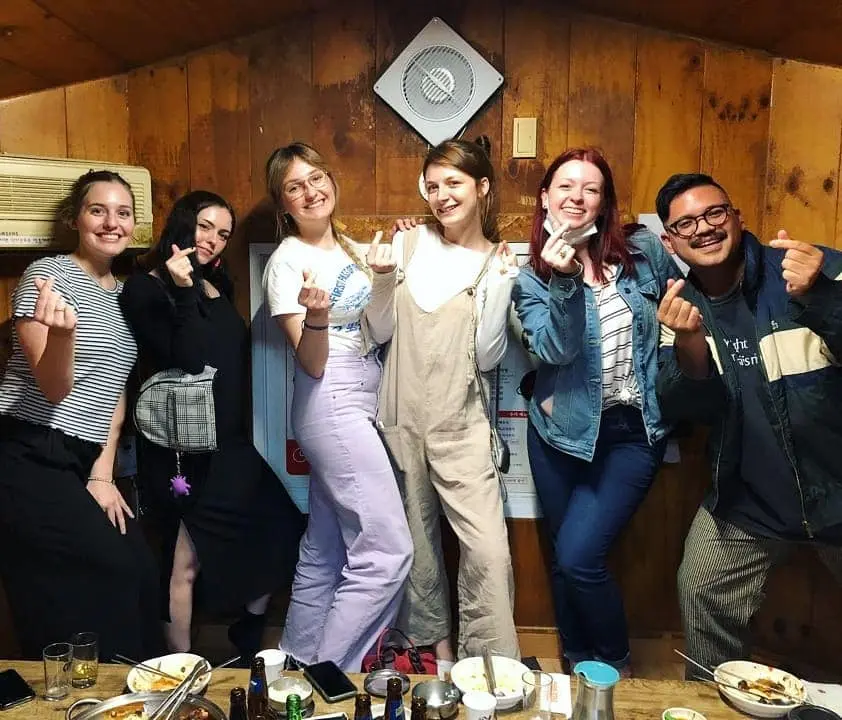
There is so much more that I could talk about and I will write future blogs about Korea but in the meantime, please let me know if you have any specific questions about living in South Korea or if you have lived there, I would love to hear about your experiences. Pop them in the comments below!


I’m really enjoying reading about day to day life and experiences in South Korea. It’s much more interesting than just reading about tourist hot spots.
Excellent write up. Enjoyed reading your life in another country. I had a feeling South Korea would be a good place to travel too. Thanks!!!
Thank you for sharing your informative article. Well written and helpful. I hope to visit South Korea someday.